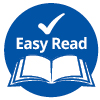Accessible communication
How accessible communication connects, includes and empowers.
Disability Action Week 2024
Disability Action Week will run from 24 November to 1 December, 2024.
This year’s theme is ‘Accessible communication: connect, include and empower.’
We want everyone to start the conversation to make our state more accessible and inclusive. Learn more below or look at our tips for hosting a Disability Action Week event.
What is accessible communication?
Accessible communication means everyone can access information, whatever their needs.
Step one is to ask how people want or need to receive information.
Some people prefer to speak face-to-face, others on the phone, or they may like to read information online or in print. Some people with disability may need information in certain ways. This includes Easy Read documents or text formatted for screen readers.
Step two is knowing how to meet those needs. This can be as simple as using plain language, choosing the right font and font size, or including an image description that describes pictures.
By providing accessible information – whether it is on social media, at events, for your business or community engagement – you can make it possible for everyone to take part.
Is accessible communication the same as inclusive communication?
No, there are differences between the two.
Accessible communication removes barriers that may prevent people with disabilities from accessing information. This applies to everything from documents, websites and emails through to signs.
Inclusive communication focuses on using language that is respectful and does not exclude anyone. There is great advice in the Australian Style Manual.
If you can, ask people for their personal preference. For example, many people with autism prefer to be called autistic.
Find out more
- Australian Human Rights Commission’s Creating accessible and inclusive communications
- Department of Education’s Inclusive workplaces inclusive communication guide
- Australian Government’s Good Practice Guidelines for Engaging with People with Disability
- “We can all help to improve communication for people with disabilities”: The Conversation
Benefits of accessible communication
Accessible communication connects people and creates communities where everyone belongs. People feel welcome and valued.
It means that more people come to events, take part in sporting activities, volunteer and thrive at work.
Read more about the benefits of accessible communication.
- Department of Health’s Asking about disability fact sheet outlines the benefits to consumers in meeting their access requirements.
- How good communication lifts participation of people with disability in community sport
- The benefits of accessible customer service to customers, employees and your business: Forbes
- Why accessible communication is good business and ethical practice (video)
Accessibility symbols
Once you have made your communication accessible, it’s time to tell people what options are available.
We have shown some of the ways people with disability’s communication needs can be met in our Disability Action Week materials. This is not a full list but gives an idea of how varied people’s needs are.
| Symbol | Description |
|---|---|
 | Closed captions Indicates that closed captions are available. The viewer can control closed captions visibility. Closed captions are a text version of the spoken part of a television, movie or computer presentation. Open captions are always in view and cannot be turned off. |
 | Sign language interpretation An Australian Sign Language (Auslan) interpretation is provided. Auslan is the language used by the Australian Deaf community. Auslan is a unique language with its own grammar, syntax and linguistics. |
 | Conversation This symbol stands for verbal communication between two people. For many people with disability, they just want to be spoken to the same way as non-disabled people. |
 | Hearing access This may be an assistive listening device or indicate the room is looped to ensure people with hearing loss can adjust their hearing aid to hear amplified sound. |
 | Telephone typewriter This device is sometimes used by people that experience hearing loss, are non-verbal or have unclear speech to communicate with the Deaf and non-deaf community. |
 | Augmented and alternative communication (AAC device) AAC devices can supplement or replace speech. People may use electronic devices to speak for them for many reasons. They may use an AAC device because their speech is unclear or because they have little to no speech. People who use AAC include people with intellectual disability, autism, severe speech sound disorders, cerebral palsy, developmental delay and genetic disorders. An individual does not need to have a diagnosed condition to use an AAC device. |
 | Easy Read is a way of presenting written information to make it easier to understand for people with low English literacy. It includes pictures. |


